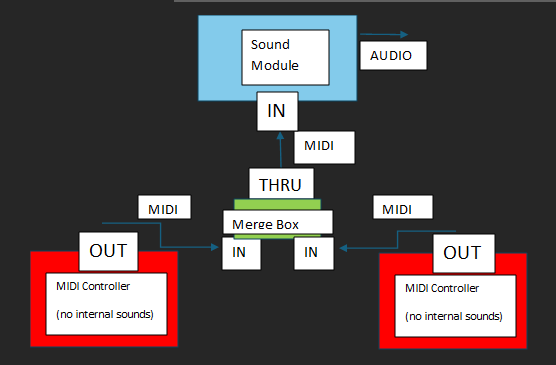Midi Midterm
1/32
There's no tags or description
Looks like no tags are added yet.
Name | Mastery | Learn | Test | Matching | Spaced |
|---|
No study sessions yet.
33 Terms
What is MIDI?
MIDI is an acronym for Musical Instrument Digital Interface
MIDI is not audio
MIDI is a protocol that allows different MIDI devices to communicate with each other using digital messages
Keyboard Controller > MIDI Cable > MIDI Instrument
MIDI messages (1s and 0s) will be transferred to MIDI instrument and then be converted to audio
MIDI Timeline
Back to the 80’s
October of 1981 – Dave Smith of Sequential Circuits proposed the Universal Synthesizer Interface as an interconnection for synthesizers. Over the following year, the name was changed to Musical Instrument Digital Interface (MIDI).
January of 1983 – MIDI was demonstrated to the public for the first time at the NAMM Show when a Roland-JP-6 and Sequential Circuits Prophet 600 were connected with MIDI
August of 1983 – The MIDI spec 1.0 was published.
Few additions added since 1.0 (general MIDI)
January of 2020 – The MIDI spec 2.0 was introduced at the NAMM Show.
Types of MIDI devices
1. MIDI Controller – is used to create and transmit MIDI messages by playing it.
2. MIDI Instrument – is primarily used to receive and playback MIDI messages converts MIDI to audio). Hardware or software.
3. MIDI Sequencer – is a multi-track recorder for MIDI. Hardware or Software.
4. Combination – Some MIDI devices are a combination of two or more types. A good example is a keyboard synthesizer, which is a controller and an instrument.
MIDI Controller
It is primarily used to create and transmit MIDI messages (takes your performance and converts it to MIDI and then transmits)
A MIDI controller is usually a keyboard but there are other types, such as a woodwind controller.
Allows skilled performers to instantly create MIDI messages by applying their skills. (Ex. Saxophone player)
It does not have an internal sound engine band therefore, does not typically receive MIDI signals or produce an audio output signal.
MIDI Instruments
A sound module is a keyboard synth sound engine without the keys.
The Yamaha TX-7 sound module was a Yamaha DX-7 synthesizer without the keyboard.
Sound modules take up less space (like the TX-7).
Less space, less expensive
A MIDI instrument can also be software on a computer. In this case, it is referred to as a virtual instrument and can be used stand-alone or as a plug-in within a DAW (AAX, VST, AU).
There are many types: synthesizers, samplers, drum instruments, etc.
MIDI Sequencer
MIDI sequencers appeared shortly after the birth of MIDI and were utilized in various ways including stand-alone hardware sequencers, software applications on a computer, and keyboard workstations.
Macintosh came out in 1984, right next to MIDI
Korgin M1 from 1989, has built-in sequencer
Today, MIDI sequencers are a part of any DAW including Pro Tools, Ableton Live and Logic Pro.
Logic Pro started as a MIDI sequencer, then audio was added later
ProTools was just an audio recorder, then MIDI was added later
Ableton Live started as something for live performance
A MIDI or instrument track is used to record, edit and playback MIDI data in a piano roll. It an be compared to a scroll used for a player piano.
The MIDI cable
A MIDI Cable is used to connect one MIDI device to another
Can be used to connect MIDI devices to a computer through a MIDI interface
Each end has a 5-pin DIN connector
In reality, only Pins 2, 4 and 5 are used
Pins 1 and 3 are not connected to anything
Transmission rate is slow: 31.25Kbaud or 31,250 bits per second
MIDI cables are uni-directional.
MIDI messages travel one bit at a time. This is called serial transmission. 1->0->0->1.
In general, it’s suggested to use a MIDI cable shorter than 50 feet (Use Ethernet MIDI for long distances).
MIDI Ports
MIDI IN – receives MIDI messages for this MIDI device
MIDI OUT – transmits MIDI messages that originate in this MIDI device
MIDI THRU – retransmits (forwards) a copy of every MIDI message received in this device’s IN port (MIDI messages received by the IN port and a copy of those are sent out through the THRU port).
MIDI USB – used to transmit and receive MIDI messages to and from a computer. A USB cable has a different connector on each end. The square and (type B) plugs into the controller.
Basic Connection
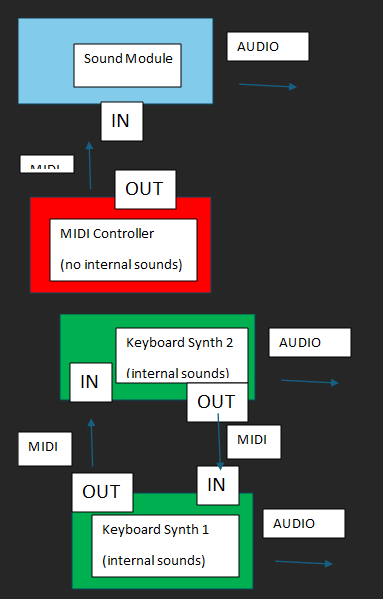
MIDI channels
Most MIDI messages are assigned a MIDI channel (the exception is the System Message).
Due to four bits, there are 16 possible MIDI channels, 1-16.
The MIDI channel is assigned to messages by the TX channel setting on a controller.
A MIDI Instrument's RX channel setting will determine which MIDI messages it will respond to.
With this Daisy Chain connection, the RX (receive) channel for the Sound Modules need to match the TX (transmission) channel for the MIDI Controller.
If the Sound Modules are set to RX on channel 1 and the Controller is set to TX on channel 1, the Modules will respond to incoming MIDI messages.
But, if the Controller is changed to TX on channel 2, the Modules will ignore incoming MIDI messages.
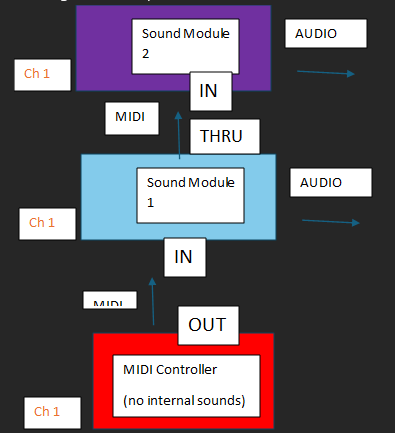
MIDI Modes
MIDI Modes determine how an instrument will respond to MIDI messages.
Poly Mode: A MIDI instrument will respond to one MIDI channel.
Omni Mode: A MIDI instrument will respond to all MIDI messages.
Module 2 will ignore incoming MIDI messages but module 1 will still respond.
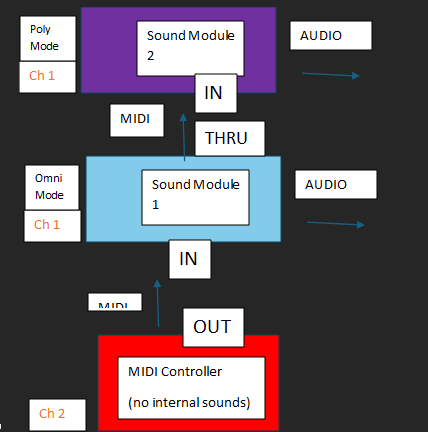
Signal Flow (MIDI Thru)
MIDI Controller > Pro Tools > MIDI Instrument > Audio
MIDI messages are created by playing keys and pads, or moving wheels, knobs, sliders and pedals on the MIDI Controller.
MIDI messages are transmitted to your computer and received by an app such as Pro Tools. A track must be armed to receive them.
With an armed track, MIDI messages played by the controller will be transmitted to the instrument as long as it is selected in the track’s output and MIDI Thru is checked in the Options menu.
MIDI messages are converted to audio signals and monitored by an audio interface.
MIDI Interface and adding a hardware instrument
A MIDI interface allows you to connect MIDI cables to a computer.
The MIDI interface itself connects to the computer via USB.
MIDI cables are used to connect hardware MIDI devices to the interface.
A MIDI interface can have multiple pairs of MIDI IN/OUT ports (the MOTU MIDI Micro Lite has 4 pairs on the back and 1 pair on the front).
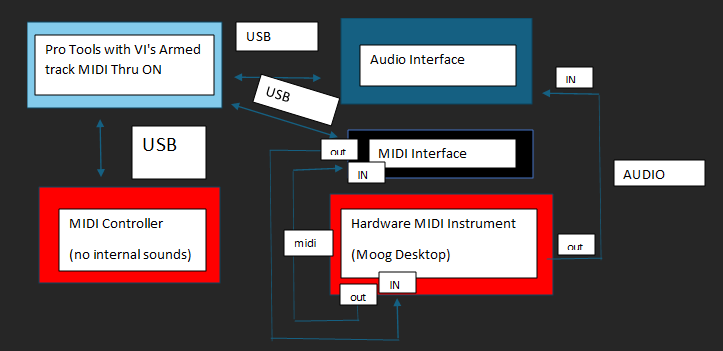
Local control
Local Control is a switch on a keyboard synthesizer that disconnects the internal sound engine from the keyboard. Use it when sequencing with the synthesizer or you will get doubling.
Audio MIDI Setup
Found in the Utilities folder, it allows you to configure hardware MIDI and audio devices.
Adding a hardware device in Audio MIDI Setup will allow it to show up in a MIDI track’s output.
The MIDI Message Table
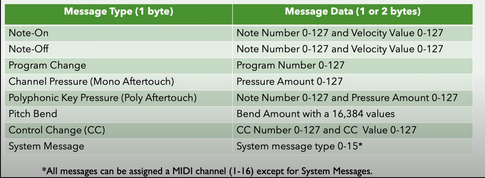
Note Number
There are 128 possible MIDI notes, ranging from 0 to 127. Every key (note) on a keyboard is assigned a number. For example, middle C = 60.
An 88-note keyboard goes from note numbers 21 to 108 (without transposition).
Numbers can also be represented as letters. For example, middle C = C3.
The total range is C-2 to G8 and an 88-note keyboard goes from A-1 to C7.
Numbers and letters are found in MIDI editors.
C3 = middle C
Note numbers are assigned in Note-On, Note-Off and Polyphonic Key Pressure messages.

Velocity Values
Velocity is the speed at which you strike your controller. A faster strike yields a higher velocity value.
There are 128 possible velocity values, ranging from 0 to 127 with 127 being the highest (hardest).
Typically, this determines Loudness (dynamics) but it could be something else depending on the destination set in the instrument.
A controller must be velocity-sensitive to create note-on messages with different velocity values, otherwise all velocity values are 64.
Velocity values are found in Note-on and Note-off messages.
Program Change messages
There are 128 possible Program Numbers in a Program Change message ranging from 0 – 127.
Program changes are commonly used to change the program (preset) on a receiving MIDI Instrument.
Changing a program number on this controller will cause the receiving MIDI Instrument to change to that same program number.

Pitch Bend
Most MIDI controllers use a wheel for bending the pitch of a sounding note. Hence, it is called the pitch bend wheel.
The wheel is bidirectional. At center, there is no pitch bend (0). Moving the wheel forward raises pitch, while moving it backward lowers pitch.
The Pitch Bend Range is the musical internal reached at maximum and minimum.
Moving the pitch bend wheel on a controller will send pitch bend messages resulting in the same pitch change from a receiving MIDI instrument.
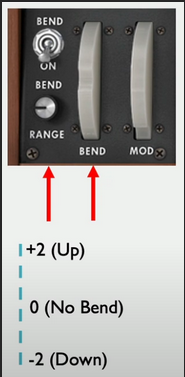
Aftertouch (including types)
With an aftertouch-capable keyboard controller, you can modulate (change) a sound by applying pressure to keys.
For example, while holding a note on your controller, vibrato can be applied by pressing harder (adding pressure) on the key. As more pressure is added, more depth (amount) is applied to the vibrato.
Aftertouch can make other changes to sound such as timbre or loudness.
Aftertouch can be transmitted with MIDI as a continuous stream with values 0 to 127. Zero is no pressure amount and 127 is maximum pressure amount.
Types
There are two types of aftertouch messages.
Channel
Polyphonic Key
With Channel pressure, the same amount of pressure will be applied to every note.
With Polyphonic Key pressure, a different amount of pressure can be applied to each held note.
In the diagram, two notes are being held but with pressure being added to just one note.
With Channel pressure, both notes will modulate at the same amount.
With Polyphonic pressure, just one note, the one being held, will modulate.

Control Change
The Control Change message (CC for short) has many functions.
As shown in the MIDI Message Table, a CC MIDI message has a CC Number 0-127, and CC Value 0-127.
We are going to cover four common CC’s from the MIDI Spec:
CC#1: Modulation
CC#7: Channel Volume
CC#10: Pan
CC#64: Sustain Pedal
Not every manufacturer follows the spec.
CC#1: Modulation
Most MIDI controllers have a Mod Wheel next to the Pitch Bend Wheel. It typically defaults to CC1 meaning CC1 messages will be generated and transmitted when moving it.
The Mod wheel is unidirectional. All the way down, there is no modulation. Moving the wheel forward increases modulation from 0 to 127.
Like aftertouch, CC1 can modulate different properties of a sound but it is most commonly used to apply vibrato. It is also commonly used to change timbre or loudness.
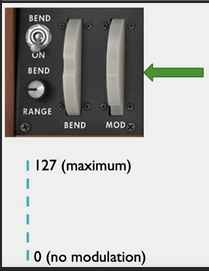
CC#7: Channel Volume
Most MIDI controllers have faders and knobs, which work well for CC7.
CC7 is used to adjust the MIDI instrument’s output level.
As the fader or knob is moved, a continuous stream of CC7 messages will be transmitted ranging from a value of 0 to 127, with 0 as silence and 127 maximum volume.
CC7 can also work well with an expression pedal that is connected to the MIDI controller.

CC#10: Pan
Most MIDI controllers have faders and knobs. A good option for a knob is CC10, which is used to pan the MIDI instrument’s audio output.
As the fader or knob is moved, a continuous stream of CC10 messages will be transmitted ranging from a value of 0 to 127, with 0 as hard left and 127 as hard right. Center is 64.

CC#64: Sustain Pedal
A sustain pedal connected to a MIDI controller is used to sustain a sound much like a traditional sustain pedal on a piano. The pedal is pressed to hold sound (after raising the hands) and released to stop (dampen) the sound.
The pedal sends a CC64 along with only two states: on and off (pressed and released)
With MIDI, a value of 0-63 is off (pedal up) and a value of 64-127 is on (pedal down).
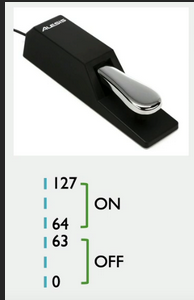
System Messages
System message type (no channel assignment*)
System Exclusive
Timing Clock

Sysex Exclusive
System Exclusive can be used to copy stored presets from one MIDI device to another of the same type. For example, you can move presets from one Moog Voyager to another.
You can also upload (backup) presets to a computer with an app like Sysex Librarian.
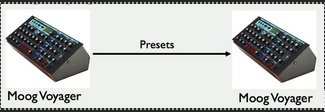
Timing Clock
Timing Clock (also called Beat Clock) is used to sync tempo between a DAW and a hardware MIDI instrument (such as a drum machine).
Steps:
1. Make sure the main DAW is transmitting Timing Clock.
2. Make sure the receiving MIDI instrument is set to reference Timing Clock (set to external clock). It will now follow the tempo set in the DAW.

Daisy-Chain
Daisy Chain
A Daisy Chain network is a solution when multiple instruments need to respond to a single controller.
A basic connection is used for Sound Module 1 but the THRU port will be used to forward MIDI to Sound Module 2.
This can be expanded by adding more sound modules and continuing to go THRU to IN for each module.
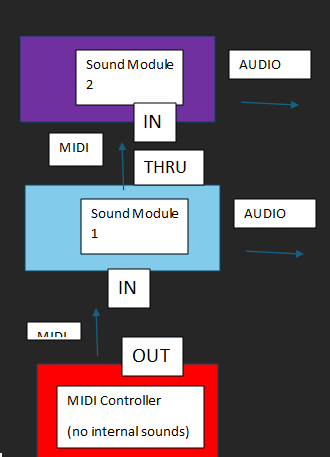
THRU Box
THRU Box – a hardware device with one MIDI IN port and multiple THRU ports.
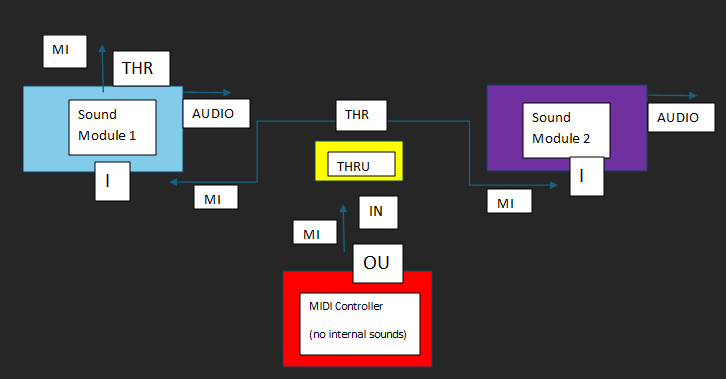
STAR Network
A Star Network is an alternate to Daisy Chaining with an advantage of all sound modules receiving MIDI messages at the same time.
Merge Box
Merge Box – a hardware device that has multiple IN ports and one OUT port. The opposite of a THRU box.
Merging
Merging is a solution for a network with multiple MIDI controllers and one shared sound module (like the opposite of Star Network)
